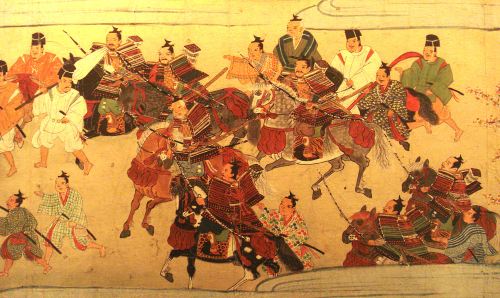Muromachi samurai (1538)
Nanban [“Southern barbarian trade” i.e European] ships arriving for trade in Japan. 16th century painting.
The medieval warrior values similar to those described in detail below were perhaps first summarized in the Chikubasho (Bamboo stilt anthology), a Muromachi-period volume providing moral instruction for samurai. Completed in 1383 by an Ashikaga deputy shogun (kanrei) named Shiba Yoshimasa (1350–1410), the text outlined explicit rules to guide the behavior of the military class. At the same time, this work also stressed the importance of cultivating both the martial arts and the traditional four scholarly accomplishments first identified with Confucius’s ideal gentleman: games of strategy, scholarship through skilled calligraphic copies of the classical texts, music, and painting. In advocating the “dual way” of both military abilities and cultural pursuits, Chikubasho identified the balance of cultural and martial knowledge sought by the warrior class. At the same time, this early warrior manual laid foundations for samurai of limited regional authority and humble origins to achieve social, economic, and political prominence previously available only to the cultivated aristocracy.
First and foremost, the samurai was a professional soldier, and thus was expected to perform martial duties at the request of his lord in exchange for remuneration in the form of land, subvassals who worked samurai fields and served in his military unit, and other tangible rewards, such as protection. The lord-vassal relationship was the primary factor that determined a warrior’s role and socioeconomic status. Since a samurai provided service to his lord by means of achievement in combat, in both military encounters and civilian life, warriors were expected to exhibit discipline and fortitude even off the battlefield. For example, a well-known Edo-period anecdote relates the deep disgrace samurai would experience at betraying hunger through the rumbling of an empty stomach, or even by acknowledging such a basic need. Upholding such stringent ideals of honor and restraint helped to ensure that warriors were constantly prepared for battle as well as other forms of adversity, while cultivating a sense of group pride and integrity lacking in nonmilitary circles.
Warriors were expected to cultivate other exemplary traits, such as loyalty, prudence, and stability, along with military leadership. Such appropriate samurai attributes were first expounded in literary sources dating to the medieval period. Literary sources highlighted samurai devotion, such as the vow to commit seppuku (ritual suicide by disembowelment; also known as hara-kiri) if faced with disgrace, especially when confronting certain enemy triumph. Willingness to follow one’s lord in death (junshi) was a related act of ultimate loyalty. Samurai demonstrated such values when imperial forces defeated the Hojo clan in 1333, and thousands of loyal warriors emulated the fate of their Hojo masters by performing ritual disembowelment, an event recorded in the Taiheiki (Chronicle of the great peace), completed by 1374.
Despite the picture of duty painted in historical accounts like the Taiheiki, loyalty was not an absolute for the military retainer throughout the medieval and early modern periods. In principle, a samurai might owe allegiance to a lord through his obligation to uphold loyalty and duty, but such a debt might also derive from material benefits, such as financial support and other rewards, offered to a warrior by a daimyo. Although traditionally the Japanese military class has been characterized as selfless and disinterested in personal gain, in reality warriors put their own needs ahead of those of their lords at various times. Certainly samurai were not immune to the allure of improving their socioeconomic position. Military units often fought on behalf of a distant lord, and even lofty moral principles could not prevent samurai bands from enjoying the spoils of warfare directly, rather than being satisfied with token parcels offered by their lords when redistribution of conquered lands occurred.
Theoretically, Bushido principles required that samurai were chivalrous champions of the weak and the disadvantaged, and protectors of the vanquished. However, since samurai had been trained to fight until capture or casualties occurred, they were often ruthless in pursuing their objectives. From the early medieval era, both the law and widespread precedents worked to prevent warriors from pursuing private interests through violent means. In the Kamakura period, legally, samurai were granted authority only to chastise lawbreakers on behalf of a superior ruler. Many incidents occurred during the medieval era in which warriors usurped ruling authority, took advantage of disorder and military power, or simply extended their responsibilities in order to achieve personal gains. Thus, many samurai failed to consistently demonstrate honorable behavior and loyalty as extolled in Bushido principles. Eventually, the civil order established by the Tokugawa shogunate eliminated samurai incentives to pursue personal gain through military prowess.
Other warrior values attest to connections between learning, lineage, social status, and righteous administration first introduced to Japan from China, along with centralized government, during the Asuka period (552–645). Long seen as the purview of the ruling class, knowledge and education became central samurai ideals during the Muromachi era as Japan experienced renewed Chinese cultural influence. As in ancient China, learned samurai were expected to be familiar with standard Chinese texts, and to master related skills such as calligraphy, poetry, and principles of strategy. Once the Ashikaga shogunate was established in Kyoto, the residence of Japan’s imperial family for nearly 1,100 years and a city distinguished by its aristocratic elegance and refinement, military rulers and other members of the warrior classes sought to establish their cultural acumen as well as the right to govern the nobility. The prominent influence of Chinese culture in the Muromachi age also contributed to the growing sense that a military figure should demonstrate characteristics typical of the superior gentleman, a moral and cultural ideal first identified by the Chinese sage Confucius (Kongfuzi), ca. 551–479 B.C.E.
